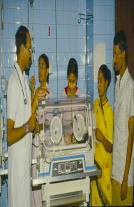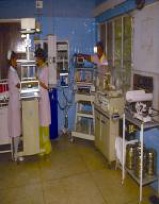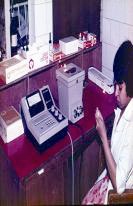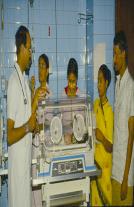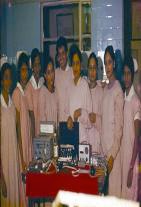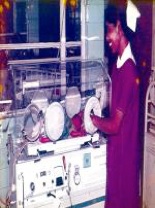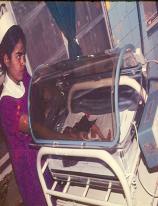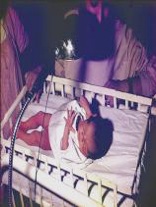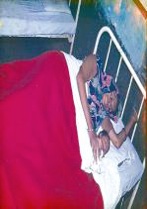Few words about my contributions towards development of Neonatology at institutional level would be quite in order because it was one field, where success has been unquestionable – more so because the neonatal services were built up from scratch in a non-teaching Municipal Corporation of Delhi run hospital, where nothing existed before 1967.In January 1967 when I joined Kasturba Hospital a 175 bedded hospital for women and children ( became 500 bedded in 1975 ) with more than 6000 deliveries a year ( more than 13000/yr.by 1990 when I retired ) newborns were uncared for,un-noticed and newborn care unheard of. There were absolutely no concept of newborn services and they were left to God to survive in this world of competition and naturally only fittest of the fit survived with unacceptable high morbidity and mortality.
Even though my experience in neonatology at AIIMS, Delhi where I got my postgraduate training, was nothing to rave about, my first day round in the post natal ward in Kasturba Hospital was shock of my life and a great lesion to remember. What I saw was abysmal to say the list. Six to seven babies huddled on one bed covered with one adult blanket in one corner of the adult ward. Yes there a ray of hope when I noticed a room heater projected towards the babies and number of small penicillin bottles filled with milk and capped with nipple for feeding the babies. Instantly I knew I have landed myself into a challenge of my life. Being new, young and coming from the country’s best medical institution – it was not easy to keep my cool. But cool I kept and took advantage of primitive basic principles of newborn care they were practicing like isolation (separate bed in one corner of the room),keeping the babies warm(using room heater and blanket), and providing nutrition (penicillin bottle for feeding).First thing I did, was to become friendly with sister-in charge and charmed my ways to her heart by showering praises for the innovative ways she was practicing essentials of newborn care .I ended by saying should we do a little better – by shifting these small babies in one of the small side room in separate baby cots and linen. She smiled and said nobody told her anything like this before and we discussed several small things for baby care. I must accept her grasp of talk was excellent and to my surprise the very next day I found one of the small side room nicely done up with four baby cradles and two Armstrong incubators and most of the other things including proper feeding bottles, all arranged in proper way. That was the birth of first newborn care unit with one nurse round the clock earmarked for these six babies (1967). With little bit of coaxing, pampering and once a while disciplining we realized we are shaping up as a good team for newborn care.
NICU Kasurba Hospital & with Self Made Indigenous Neonatal equipments at display for the then Chief Minister of Delhi in 1978-79
As the organized neonatal care started showing results it was not difficult to snatch a small new block ment to be septic labor room, though not without strong opposition from the Obstetricians. With some modifications in the structure we were able to expand the nursery to 10 beds with more equipments and staff by 1968 (within one year of starting our first 6 bedded nursery).With increasing number of admissions and referral from other MCD hospitals we were finding it extremely difficult to accommodate the demands on bed. At this stage we started well thought out strategy of early discharge and introduced the system of allowing mothers (strict aseptic technique observed) into the nursery for baby care in 1970.Results were amazing. We suddenly discovered pressure on beds and nursing, and infection rate went down tremendously. Follow up rate of discharged babies and breast feed rate went up and post discharge readmission for gastroenteritis and malnutrition came down significantly. With this success and realizing the importance of sense of involvement of mother, we yet again started a new venture – we created a 10 bedded Mother-Based Newborn Care Unit and christened it as “Matreesneh – mother’s
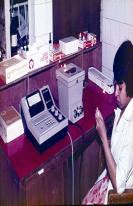
love” in the postnatal ward itself with wood and glass partitions so that other mothers can see mothers taking care of babies under supervision of nursing and medical staff and thus get encouraged. All babies above 1500 Gms who did not need any intensive care or monitoring was accommodated in this unit and every possible care was given by mothers themselves under the supervision of nursing personnel. Health education on hygiene, breast feeding, nutrition, immunization and problem sorting was daily feature of this unit. Success was unique by every parameters and it had great impact on mothers both in the unit and those in the post natal ward – most developed unique self confidence of caring for small and sick babies. We were happy because it brought about less demand on nursing and medical personnel in our NICU Unit, thereby they were able to provide greater attention to babies who were sick and needed constant monitoring.
With increasing number of deliveries from 6000 to 13000 a year the hospital expanded to 500 beds in a new four stories building in 1975, where every thing – Labor Room, Resuscitation Room, O.T., Post-operative Room and post natal wards were planned methodically. In this new block we had the pride of the place where we started 35 bedded
state-of-the-arts Neonatal Intensive Care Unit with all the imported Air Shield equipments necessary for level III care including ventilators and transport incubators – perhaps no unit in the country was that well equipped at that point of time (1975).To cap it all we also established Micro-biochemistry side lab. In the unit itself where 24
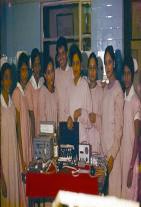
Parameters of microchemistry needed for newborn care could be performed. Perhaps even today no NICU in the country can claim to have microchemistry lab in the unit. By late 70s unit started being noticed and recognized all over the country and by early eighties many interested young pediatricians both from teaching and non-teaching institutions joined us for in-n-service training program. By late seventies our unit was considered as one of the four best neonatal units in the country beside AIIMS, Delhi PGI, Chandigarh, Safardarjung Hospital, Delhi. When I took voluntary retirement in December 1989, I had risen from Jr.Consultant to Head of the Institution as Medical Superintendent. The department grew from 20 pediatrics bed to 40, from 50 postnatal beds to 150, from no nursery bed to 35 bedded state-of-arts NICU, from no mother based nursery to 10 bedded unit and 3 doctors team to team of 33 doctors.
Before leaving I could also add a WHO aided Diarrhea unit and WHO Multricentric Research Scheme on efficacy of Hepatitis B vaccine in newborn. Most people across
The country felt it is more creditable because the unit blossomed in non-teaching, corporation run hospital – a rare achievement even today.
Looking back I feel the sense of fulfillment that I have been able to contribute something to neonatology at a time and place, when and where nothing much existed in the country.


